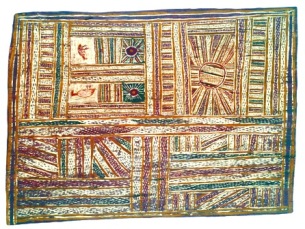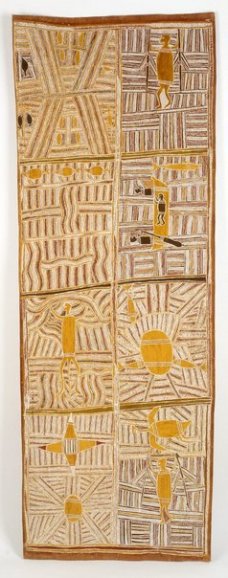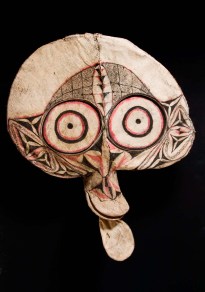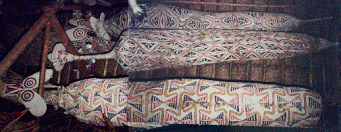Yirrkalla (Arnhem Land, Australia) Bark Painting
The first bark painting is called the Three Suns. I couldn’t find much information about it, other than it was made by the Yirrkalla people and recovered in 1946. It is similar to the second bark painting, depicting the Djanggawul Myth. Both bark paintings are complex. The Djanggawul painting was painted by four men, consisting of eight different sections. This painting represents creation. If you look closely at the sun shapes, the beams of light shoot outward from the circular center. Both paintings consist of mostly straight lines, squares, right angles and diagonal patterns. There are distinct boarders dividing the sections as well. This is because the area and the isolation from the rest of the world, their artistic styles came from their familiarity of hunting and gathering. Their art reflected what they were most familiar with, long lines like the blades of grass or vines.
Uramont Baining (Island Melanesia) Day Dance Bark Cloth Mask
This mask is called Mendaska. The Uramont people paint these masks with patterns that have been passed down from their ancestors. The day dance is associated with harvest. During the celebration women would wear bags with cooked garden foods, and the masked dancer would carry wild pig meat. These masks can be over 15 feet tall, representing longevity. Inspirations for the paintings come from the fern leaves, grasses, banks of the river or streams, and mist. There are also some animals, the dog, the crocodile and a lizard. If you compare these photographs to the ones from Yirrkalla, you will notice that these lines are curvier in nature. You see circles, triangles with bent sizes, and on the trunk portion of the mask repetitive curved patterns that cover the entire length. The people live in the jungle but may have artistic influences from the Sulka or the Tolai who are near the ocean.



